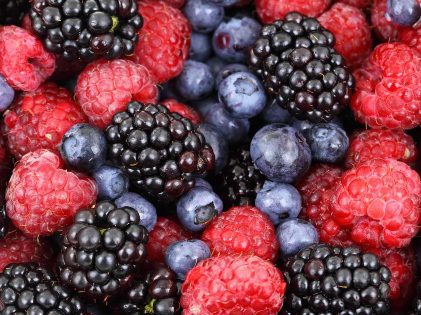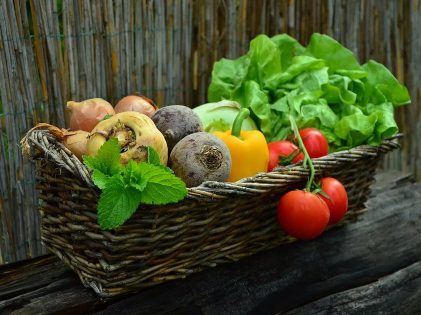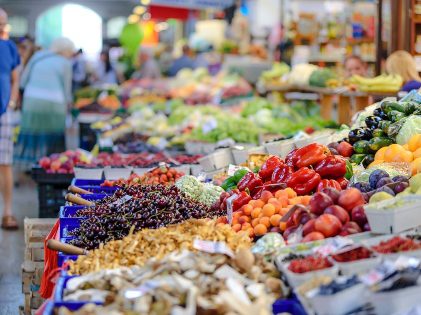Is it important to add various colorful fruits and veggies to your daily diet? Definitely. You should incorporate a diversity of colorful food items into your platter as they offer several minerals, vitamins, antioxidants, as well as phytochemicals that are known for their healing powers. Eating the rainbow, as it is popularly known, is beneficial for both kids and adults. You can zero in on the food items that you and your family members take a liking to. Pick them up and develop a habit of eating them daily. Every color in these fruits and veggies is due to the presence of specific natural chemicals called phytonutrients. Each of them points out the abundance of a specific nutrient. More details follow.
Red Fruits and Vegetables
 Fruits and veggies that are red, contain phytochemicals like lycopene as well as ellagic acid. As per various studies, lycopene and ellagic acid are powerful nutrients that play a key role in fighting cancer. It has been found that having tomato sauce daily can reverse the progression of prostate cancer. There are other health benefits too.
Fruits and veggies that are red, contain phytochemicals like lycopene as well as ellagic acid. As per various studies, lycopene and ellagic acid are powerful nutrients that play a key role in fighting cancer. It has been found that having tomato sauce daily can reverse the progression of prostate cancer. There are other health benefits too.
The content of lycopene is higher in watermelon as compared to tomatoes. Watermelon also contains a high amount of citrulline, another essential phytonutrient. Citrulline may be effective in treating erectile dysfunction. Strawberries can prevent as well as reverse esophageal cancer. Consuming lycopene and beta-carotene from whole foods can cut down the risk of cancer. Some healthy red foods are watermelon, tomatoes, strawberries, apples, pomegranate, cherries, grapes, beets, red peppers, raspberries, cranberries, red onions, etc.
Yellow and Orange Fruits and Vegetables
Yellow and orange veggies have high contents of vitamin C and carotenoids, like beta-carotene. Beta-carotene is known to convert to vitamin A when consumed, which aids in cell growth and improves vision. Citrus fruits contain hesperidin, a unique phytonutrient that boosts blood flow. If you get cold hands and feet, taking an orange a day may keep your hands and feet warm. Citrus fruits help cut down the risk of stroke. Some yellow and orange fruits and veggies are lemons, oranges, mangoes, pineapple, peaches, grapefruit, sweet potatoes, winter squash, golden beets, yellow summer squash, orange and yellow peppers, corn, cantaloupe, etc.
Green Fruits and Vegetables
 Greens are healthy for you. Green fruits and veggies are abundant in vitamin K, isoflavones, isothiocyanates, and lutein, all of which promote blood and bone health. Aside from that, folate is present in green vegetables. Pregnant women should consume folate to ward off congenital disabilities. Cruciferous veggies such as broccoli boost immune function. Dark leafy veggies such as kale boost mood. Kiwi fruit, as per studies, alleviates maladies such as common cold, insomnia, etc., and may play a major role in repairing DNA damage. Some examples of essential green fruits and vegetables are green apples, green grapes, asparagus, avocado, kiwi fruit, peas, spinach, green beans, broccoli, kale, brussels sprouts, zucchini, collard greens, romaine lettuce, arugula, edamame, and swiss chard.
Greens are healthy for you. Green fruits and veggies are abundant in vitamin K, isoflavones, isothiocyanates, and lutein, all of which promote blood and bone health. Aside from that, folate is present in green vegetables. Pregnant women should consume folate to ward off congenital disabilities. Cruciferous veggies such as broccoli boost immune function. Dark leafy veggies such as kale boost mood. Kiwi fruit, as per studies, alleviates maladies such as common cold, insomnia, etc., and may play a major role in repairing DNA damage. Some examples of essential green fruits and vegetables are green apples, green grapes, asparagus, avocado, kiwi fruit, peas, spinach, green beans, broccoli, kale, brussels sprouts, zucchini, collard greens, romaine lettuce, arugula, edamame, and swiss chard.
Blue and Purple Fruits and Vegetables
There is an abundance of resveratrol and anthocyanins in blue and purple fruits and veggies. These phytonutrients are known for their abilities to fight against cancer and aging. According to research, the bioactive phytochemicals present in berries help in repairing damage caused by inflammation and oxidative stress. Red cabbage is known to contain high levels of antioxidants and is, therefore, considered among the best superfoods. Blueberries, blackberries, red grapes (purple), figs, prunes, plums, red cabbage (purple), and eggplant are some popular blue and purple fruits and veggies that you must try.
White and Brown Fruits and Vegetables
 White and brown fruits and veggies may not have those bright colors as others, but they too contain phytonutrients and are healthy for you. Cauliflower is among those cruciferous veggies like broccoli, with that high percentage of sulforaphane, a compound that helps in fighting cancer. Onions and garlic belong to the allium family of vegetables and contain quercetin and allicin, both powerful compounds that fight cancer. White button mushrooms have phytonutrients that restrict aromatase activity. A few examples of white and brown foods are mushrooms, cauliflower, onions, garlic, potatoes, jicama, parsnips, and daikon radish.
White and brown fruits and veggies may not have those bright colors as others, but they too contain phytonutrients and are healthy for you. Cauliflower is among those cruciferous veggies like broccoli, with that high percentage of sulforaphane, a compound that helps in fighting cancer. Onions and garlic belong to the allium family of vegetables and contain quercetin and allicin, both powerful compounds that fight cancer. White button mushrooms have phytonutrients that restrict aromatase activity. A few examples of white and brown foods are mushrooms, cauliflower, onions, garlic, potatoes, jicama, parsnips, and daikon radish.
Add these fruits and vegetables to make a beautiful breakfast, exciting salads, a lively lunch, or a rainbow meal. Do not forget to consult a professional nutritionist.
